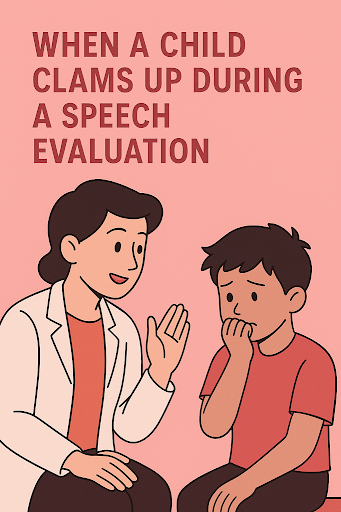What to Do When a Child Clams Up During a Speech Evaluation
Strategies for engaging reluctant children and gathering accurate assessment data

You've set up the testing materials. The room is quiet. You smile and introduce yourself.
But the child won't speak. Or they whisper. Or they stare at the table.
And now you're stuck.
Every SLP eventually runs into a child who shuts down during evaluation — whether due to anxiety, shyness, trauma, selective mutism, or just being overwhelmed. When that happens, it's easy to panic or feel stuck.
This article will walk you through how to adapt your evaluation approach without compromising data quality — and how to write it all up when the results are limited.
Why It Happens
Kids might clam up during an evaluation because:
- They've had negative experiences with testing or adults
- They have social anxiety or selective mutism
- They're overstimulated, tired, or emotionally dysregulated
- They're non-speaking or minimally verbal communicators
- You're unfamiliar — and that's scary
Whatever the reason, forcing participation usually backfires. The better move is to slow down, observe, and flex.
Step 1: Change the Environment
Sometimes the space is the problem. Try:
- Dimmed lighting or fewer visual distractions
- Bringing in a familiar adult (teacher, parent)
- Giving the child some control (e.g., choice of materials)
- Using a play-based setup instead of seated testing
The goal is to lower the stakes — not to trick the child into talking, but to help them feel safe.
Step 2: Shift from Testing to Connecting
If the child isn't talking yet, stop scoring — and start observing. Try:
- Parallel play
- Imitation games (e.g., you draw a line, they copy)
- Gesture-based communication
- Offering choices ("Do you want the car or the dinosaur?")
Every communication attempt — verbal or not — gives you data.
Step 3: Try Informal Measures First
If standardized testing isn't possible, pivot to informal tools:
- Language samples (from the classroom, if needed)
- Parent/teacher checklists (CCC-2, SSIS, etc.)
- Observations across settings
- Play-based interaction to assess receptive skills, joint attention, or social reciprocity
You're still assessing — just through a wider lens.
Step 4: Use Dynamic Assessment
Dynamic assessment (test–teach–retest) can help:
- Reduce pressure
- Show how the child learns, not just what they know
- Reveal potential underperformance due to anxiety or low exposure
It's especially useful when cultural or emotional factors may be skewing results.
Step 5: Know When to Pause
If the child is in distress or completely disengaged, it's okay to stop the session and reschedule.
Include in your report:
"Due to limited participation, formal testing could not be completed. Informal observations and caregiver input suggest further assessment is warranted when the child is more regulated."
Protect the child's emotional safety and your clinical integrity.
Step 6: Write a Thoughtful Report (Even With Limited Data)
Even if you didn't get full scores, you can still write a strong, defensible report. Include:
- What was attempted (and why it was modified)
- The child's behavior and affect
- Observations of interaction and communication style
- Input from parents and teachers
- A plan: further eval, trial intervention, or classroom support
What matters is showing your clinical reasoning, not just test scores.
How SLP Score Helps When Kids Shut Down
When evaluations don't go as planned, SLP Score helps you:
- Document observations alongside (or in place of) standardized scores
- Generate plain-language summaries about what was attempted and why
- Add dynamic assessment or informal data into your report flow
- Export editable reports you can build on later
Because some of the best evaluations don't come from perfect testing — they come from clear, compassionate observation.
When a Child Shuts Down, You Don't Fail — You Adapt
Let SLP Score help you document what matters most.
Start Here →